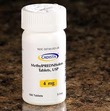Pronunciation
pred-ni-so-lone - Pronunciation guide
Brand Names
- Delta Albaplex® / Delta Albaplex® 3X
- PrednisTab®
- Temeril-P® Tablets
Description
 Prednisolone is a synthetic corticosteroid with effective anti-inflammatory properties. Because horses do not absorb oral prednisone well, some veterinarians prefer to use other corticosteroids or oral prednisolone which is more readily absorbed by the horse's system.
Prednisolone is a synthetic corticosteroid with effective anti-inflammatory properties. Because horses do not absorb oral prednisone well, some veterinarians prefer to use other corticosteroids or oral prednisolone which is more readily absorbed by the horse's system.
While oral prednisolone can be administered to horses, the small tablet sizes available make it inconvenient, so equine formulations of oral dexamethasone are recommended. The injectable formulation of dexamethasone can be given IV to horses with acute bronchoconstriction and dyspnea.
Usage
Prednisolone is given systemically to decrease inflammatory and immune responses. For years, it has been given orally to treat heaves in horses and other allergic or immune disorders.
In contrast, prednisolone tablets have excellent bio-availability and veterinarians are considering them to be more useful as a therapeutic agent in horses.
Dosage and Administration
 Prednisolone Prednisolone |
||||
|---|---|---|---|---|
| Method | Dosage (click row for calculator) |
Concentration | Period | Duration |
| Oral | 0.25-1 mg/kg | 20 mg/tablet | NA | |
| Prednisolone Acetate | ||||
| Intramuscular injection | 0.25-1 mg/kg | 100 mg/ml | NA | |
| Prednisolone Sodium Succinate | ||||
| Intravenous injection | 0.25-1 mg/kg | 50 mg/ml | Every 12, 24 or 48 hours1 | NA |
Notes:
|
||||
Side Effects
Short-term use of prednisolone is unlikely to cause adverse side effects in horses.
Precautions
Chronic or inappropriate use of corticosteroids can cause life threatening hormonal and metabolic changes. Animals that have received long-term therapy should be withdrawn slowly by tapering the dosage and prolonging the interval between doses.
Animals receiving systemic corticosteroids may be more susceptible to bacterial or viral infections which can be masked by the medication.
Use of corticosteroids in young animals should be avoided or monitored closely because of immune suppression and the risk of gastrointestinal ulcers.
Corticosteroids have been known to cause laminitis in horses, although prednisolone is not thought to be in the higher risk category.
Corticosteroids should be avoided during pregnancy and lactation unless the benefits outweight the risks.
In all cases, on-going consultation with a veterinarian is recommended.
Prednisolone is a prescription drug and U. S. Federal law restricts this drug to use by or on the order of a licensed veterinarian.
Prednisolone would be prohibited in any drug-free competition.
Interactions
Risk of electrolyte imbalances are increased when amphotercin B or diurectics, such as furosemide, are given with corticosteroids. Corticosteroids may increase insulin requirements.
Drugs that may cause drug interactions with prednisone include: salicylate, phenytoin, phenobarbital, rifampin, cyclosporin, erythormycin, mitotane, and anticholinesterase drugs, such as neostigmine.
Risk of GI ulcers is increased if corticosteroids and nonsteroidal anti-inflammatory drugs are given at the same time.
Overdose
Short-term administration of even large doses is unlikely to cause serious systemic effects.
Problems related to long-term administration of prednisolone include suppression of normal adrenal function, latrongenic Cushing's disease, and metabolic crisis due to abrupt withdrawal from prednisone.
Images
 Cadista Methrylprednisone Tablets
Cadista Methrylprednisone Tablets
Literature
